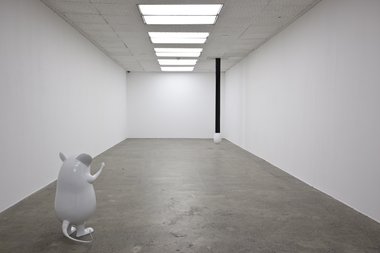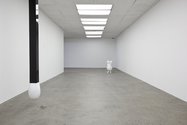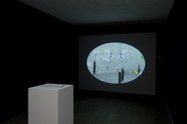John Hurrell – 20 January, 2011
Rain also, like the nearby sculpture, seems to refer to Parekowhai with his birds, logs, elephants, 'weeds' and long coloured blocks. (The rain would be a sardonic reference to Maaori tears?) In contrast to the sculpture with its loaded symbolism Oh (with Rain's use of chance) could be laughing at Parekowhai's efforts to control the meaning of his work with laboured titles.
Seung Yul Oh is one of those dazzling but puzzling talents who is good at utilising many media. Assorted art disciplines are coped with effortlessly. When he wants to be he can be a brilliant painter (with an energetically graphic, tactile and spontaneous sensibility) but obviously - as has been revealed over the last year or two - it is sculpture that he is concentrating on now. I’ve always found this current work a bit too cool compared to the earlier paintings (especialy those of 2008), though the sculpture is nevertheless seductive with its use of colour, simple form and glossy sheen.
So here in the long room we have a spatially simple installation of a large but cute white rat contemplating an inverted black match suspended from the gallery ceiling. It is obviously set up as meaningful narrative, a 3D illustrative image that viewers are prodded to imaginatively find captions for.
The scene appears to be motivated by didacticism, perhaps in the manner of Michael Parekowhai. Seung seems to be trying to milk the binary symbolism of black versus white - using imagery to seemingly finger-wag some historical/political point under the viewer’s nose. But a white rat admiring an inverted (disadvantaged?) black match’s latent potential for creative flare seems a little mischievous in its ruefulness. Is Oh disguising a hard truth under the veneer of being whimsical and humourous? Or is he taking the Mickey out of being ‘staunch’?
In the adjacent smaller gallery he presents a cavelike environs for an interactive installation, Rain, the result of a collaboration with Jeff Nusz of Screens. A horizontally aligned oval is projected onto the end wall and its internal motifs generated and positioned through a computer keyboard on a table. You can play with the same imagery by clicking here and interacting with the programme through the computer you are looking at and using now.
On your screen you will be seeing a white, snowy or sandy, landscape with a barely detectable straight horizon line and above it, streaky overcast clouds. When you press on your keys and move your tapping hand from left to right you will generate left to right movement of falling raindrops on the oval whitescape - descending to splatter on the icy ground. Sustained finger pressure on the keypads, or multiple tappings with several fingers at once, generates coloured blocks being ejected up out of the earth, or sprouting plants and dark logs. These slowly moving items are then replaced by yellow ducklings, stunted woodpeckers, letters, character symbols and eventually bubble-blowing flying elephants. The keyboard use also determines the initial notes and subsequent build-up of the accompanying delicate chimelike music.
Looking at this activity while seated in front of your work or homeplace computer is very different from standing in the darkened room at ARTSPACE, peering at the far wall. Because there are many animated pop ups and squawking bobbing heads that can disturb your leisured surfing at home, Rain’s presentation has a different context and physicality than when experienced in ARTSPACE.
Here it is an interactive film that you are not so physically close to. To be there requires a more purposeful stamina, for the viewer’s body is more vulnerable in the public space of an austere dark room. It is seen by others and the air is slightly chilly. The screen space is slightly more immersive, the field deeper.
Oh’s Rain project appears to be motivated by play, being recreation for its own sake, and exulting in pleasure from colour, humour and movement - with no other agendas. The delights of viewer participation.
It also, like his nearby sculpture, seems to refer to Parekowhai with his birds, logs, elephants, ‘weeds’ and long coloured blocks. (The rain would be a sardonic reference to Maaori tears?) In contrast to the sculpture with its loaded symbolism Oh (with Rain‘s incorporation of chance) could be laughing at Parekowhai’s efforts to control the meaning of his work with laboured titles. By using viewer involvement, he is through his collaboration with Nusz, possibly advocating a more visceral artistic experience, one that is less loaded up with tropes. And less predictable.
John Hurrell





 Two Rooms presents a program of residencies and projects
Two Rooms presents a program of residencies and projects Advertising in this column
Advertising in this column



This Discussion has 0 comments.
Comment
Participate
Register to Participate.
Sign in
Sign in to an existing account.